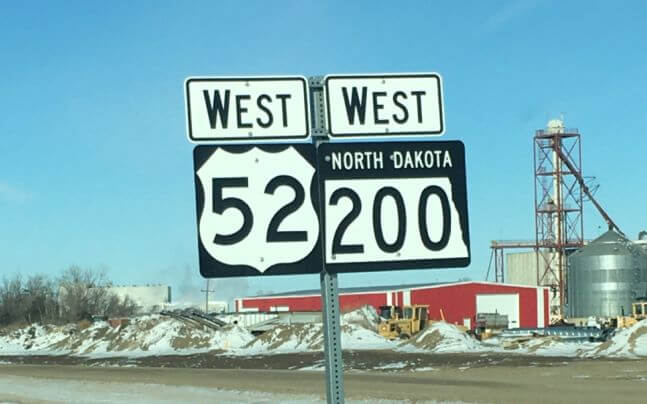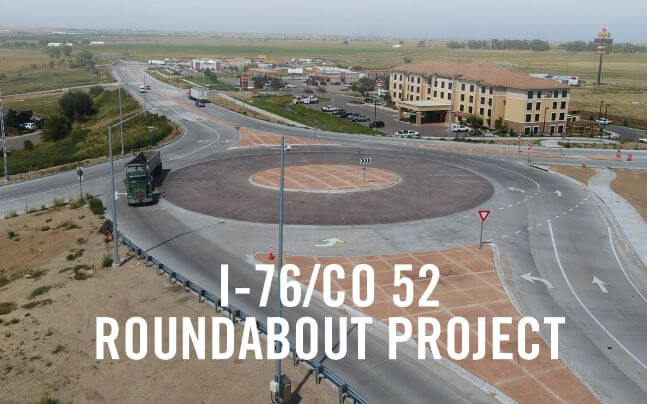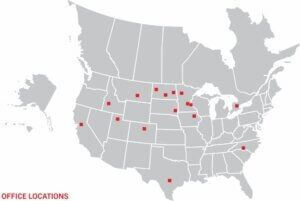Ulteig Fights Tight Timeline to Secure Environmental Permits and Improve Passing Lanes along U.S. 52

August 5, 2022
Carrington, North Dakota – Running through the heart of North Dakota, from the prairie pothole region in southeastern North Dakota to the rolling hills region of northwestern North Dakota, U.S. Highway 52 is a critical corridor for the international transportation of agriculture and energy products.
Over the years, the 362-mile highway that runs from the Canadian border to the Minnesota-North Dakota border has experienced a dramatic rise in traffic, particularly among heavy-duty trucks and agriculture equipment which take the 220-mile stretch from Carrington to Portal.
To improve the flow of traffic, reduce the hazard of slower-moving ag equipment, which use the highway for both local and regional movements, and to stabilize transportation speeds, the North Dakota Department of Transportation (NDDOT) turned to Ulteig to design passing and turn lane improvements along this stretch of U.S. 52.
The first of five segments to be constructed in this multi-year project began with planning, environmental and field studies in June 2021, and was bid in May 2022. Construction is scheduled to begin in June 2022. Ulteig focused on designing passing lanes on both sides of U.S. 52 from Carrington to Fessenden – about a 36-mile stretch.
“The NDDOT is planning on adding passing lanes all the way from the Canadian border down to Carrington,” said Ulteig Technical Manager Thomas Fakler. “They were able to secure a grant, which accelerated our project and condensed an 18-month project to nine months.”
“We’re working on increasing efficiency for drivers on one of the most traveled routes from Minot to Carrington,” Fakler said. “Our project design gives people the opportunity to pass a lot of slow-moving traffic. It’s desirable for all users of the road because drivers can expect more consistency in speed during their travels.”
While the purpose of designing these passing lanes was to accommodate an increase in traffic, Ulteig’s plan is to address a higher priority issue — making the transportation route accessible and efficient for all vehicles by considering vehicle size and speed of traffic.
“According to a scoping document prepared by the NDDOT, this corridor averages 33% truck traffic, whereas the rest of North Dakota averages 21%,” said Ulteig Project Manager Josh Kueber. “You can see it’s being used by a lot larger vehicles than other highways in the state.”
“People are often getting stuck behind slow moving traffic and then try to pass,” added Fakler. “With the current highway layout there is a risk that creates a speed differential for both slow-moving large vehicles and faster-moving small vehicles.”
Passing Lanes Require Thorough Environmental Consideration
The Carrington-Fessenden project crosses the prairie pothole region of North Dakota. Prairie potholes are depressional wetlands (primarily freshwater marshes) found most often in the Upper Midwest.
According to the United States Environmental Protection Agency, the prairie potholes left from the formerly glaciated landscape fill with snowmelt and rain and provide habitat to more than 50 percent of North American migratory waterfowl.
“The environmental evaluation process was a critical component of securing this project, especially because our scope crosses a few different watersheds and is situated in such a unique landscape,” Kueber said. “Ulteig’s Environmental team completed a Documented Categorical Exclusion (CATEX) along with other surveys, delineations, reviews and assessments which evaluated both the current highway landscape and the effects of the proposed passing lanes project.
The team was able to secure a Section 404 permit from the U.S. Army Corps of Engineers (USACE) successfully on a very tight timeline, working with the NDDOT to create a plan to prepare necessary documents ahead of time and ensure the permit was received prior to bid. This was uniquely difficult in that nine on-site wetland mitigation sites and 26 ditch shifts were required to mitigate all the wetland impacts.
Ulteig Completes Carrington/Fessenden Project in Half the Time
“We had to identify the critical milestones in our project timeline to stay on track,” Kueber said. “One critical pressure was funding, which NDDOT was at risk of losing up to 10% of the grant for the project if it wasn’t bid in 2022.
“Josh Kueber and Mike Huffington, our Market Development Manager, did a great job of coordinating with our sub-consultants, along with our internal design and field teams including: survey, right-of-way, hydrology, GIS, roadway design team and everyone within Ulteig,” said Fakler. “Everybody understood the tasks in front of them, what needed to be completed and the downstream effects of the tasks if they were not completed.”
Kueber added that he was especially proud of the team for overcoming the time constraint on the project and moving quickly to complete the plan set and secure permits required to implement the first set of passing lanes.
“It’s just a matter of the whole team coming together, putting extra hours in — a lot of late nights and weekends,” Fakler said.
Also of note: the team successfully designed the entirety of the Carrington-Fessenden highway section with no permanent right-of-way takes from nearby landowners and were able to avoid almost all the utilities.
Planning: 36 Miles Down, 84 to Go
Fakler, Kueber, Huffington and team now enter the second and third design project segments for U.S. 52 with new perspectives and tactics. Lessons learned include:
- Jurisdictional Determination — “We’re constantly looking at our schedules with the NDDOT and verbally indicating possible pitfalls or issues; so, we can continue coming up with solutions that fit their timeline and collaborate with them to provide solutions,” Fakler said. “A perfect example we encountered in this current project is jurisdictional determination, which is a set of guidelines defined by Army Corps of Engineers as to whether wetlands or streams fall under federal jurisdiction pursuant to the Clean Water Act. The team worked hand in hand with the NDDOT to find out a path forward and move on without the jurisdictional determination.”
- Quality of Life – The U.S. 52 project offers a reminder about the impact that engineering can have on the real, everyday lives of people who use the road. Kueber recalled public input meetings he attended in Carrington, Harvey, Velva and Minot at the beginning of the project. “I remember a lot of people were excited about the passing lanes, I didn’t hear anyone against it,” Kueber said. “It will be greatly appreciated by anyone who drives that corridor. Anytime we can improve someone’s life, that’s work we feel good about.”
- Same Road, Different Needs – While some may perceive North Dakota as a wide, flat state, the truth is North Dakota’s terrain changes from one end of the state to the other. Each phase of the project offers its own complexities, forcing the Ulteig team to develop custom solutions to meet the challenges that the terrain presents, as well as the needs of the residents in different parts of the state.
Learn More About Ulteig’s Transportation Capabilities
Ulteig’s Transportation Practice has a long history of successfully completing transportation projects. Through firsthand experience, the firm is accustomed to meeting the requirements and expectations of federally funded projects and state departments of transportation as well as regional and local levels of government. This includes the planning, design and construction services for complex urban intersections, corridor retrofits and rural highways. Ulteig stays attuned to cutting-edge practices and community elements of transportation facility development. We understand that facility planning and design must be context-sensitive and cost-sensitive, environmentally friendly and sustainable. Learn more, visit Ulteig.com.
WHAT MAKES ULTEIG DIFFERENT?
From global energy producers to locally funded cities and private developers to government agencies, the clients we serve encompass a broad range of relationships and projects. Find out why Ulteig is a leader in the engineering industry.
Contact Us


